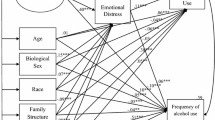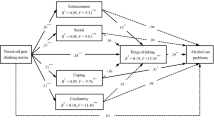Abstract
The aim of the present study was to explore the association between family functioning, coping strategies, peer influences and alcohol use among Italian adolescents. Nine hundred and sixty-three Italian adolescents, aged from 14 to 17 years, completed self-report measures assessing alcohol use, family functioning, and coping strategies. According to previous research, adolescents were categorized into non-drinkers, social, binge and heavy drinkers. Results showed that adolescents belonging to groups characterized by alcohol misuse differ in terms of coping strategies, family functioning dimensions, and typology of friends. In particular, heavy drinkers appeared to have more friends who drink alcohol on a regular basis and they were younger when started to drink on a regular basis than other drinking groups. Moreover, discriminant function analysis shows that avoidant coping strategies, early age of drinking, great number of friends who regularly drink alcohol and family dysfunctions are significant in the differentiation of drinking groups, separating heavy drinkers from others categories of drinkers
Similar content being viewed by others
References
Amato, P. R., & Gilbreth, J. G. (1999). Nonresident fathers and children’s well-being: a meta-analysis. Journal of Marriage and the Family, 61, 557–573.
Amirkhan, J. H. (1990). A factor analitically derived measure of coping: the strategy coping indicator. Journal of Personality and Social Psychology, 59, 1066–1074.
Baiocco, R., D’Alessio, M., & Laghi, F. (2010). Binge drinking among gay and lesbian youths: the role of internalized sexual stigma, self-disclosure and individuals’ sense of connectedness to the gay community. Addictive Behaviors, 35, 896–899.
Baiocco, R., et al. (2012). Factorial and construct validity of FACES IV among italian adolescents. Journal of Child and Family Studies. doi:10.1007/s10826-012-9658-1.
Bandura, A. (1977). Social learning theory. Englewood Cliffs: Prentice-Hall.
Beutler, L. E., Moos, R. H., & Lane, G. (2003). Coping, treatment planning, and treatment outcome: discussion. Journal of Clinical Psychology, 59, 1151–1167.
Borsari, B., & Carey, K. B. (2001). Peer influences in college drinking: a review of the research. Journal of Substance Abuse, 13, 391–424.
Borsari, B., & Carey, K. B. (2006). How the quality of peer relationships influences college alcohol use. Drug and Alcohol Review, 25(4), 361–370.
Brook, J. S., Brook, D. W., & Richter, L. (2001). Risk factors for adolescent marijuana use across cultures and across time. Journal of Genetic Psychology, 162, 357–374.
Cacioppo, M., Pace, U., & Zappulla, C. (2013). Parental psychological control, quality of family context and life satisfaction among Italian adolescents. Child Indicators Research, 6, 179–191.
Catanzaro, S. J., & Laurent, J. (2004). Perceived family support, negative mood regulation expectancies, coping, and adolescent alcohol use: evidence of mediation and moderation effect. Addictive Behaviors, 29, 1779–1797.
Clark, K. K., et al. (1995). Validation evidence for three measures of coping. Journal of Personality Assessment, 65(3), 434–455.
Cocoradă, E., & Mihalaşcu, V. (2012). Adolescent coping strategies in secondary school. Procedia - Social and Behavioral Sciences, 33, 188–192.
Delk, E. W., & Meilman, P. W. (1996). Alcohol use among college students in Scotland compared with norms from the United States. Journal of American College Health, 44(6), 274–281.
Di Grande, L., et al. (2000). Alcohol use and correlates of binge drinking among university students on the Island of Sardinia, Italy. Substance Use & Misuse, 35(10), 1471–1483.
Ennett, S. T., et al. (2008). The social ecology of adolescent alcohol misuse. Child Development, 79, 1777–1791.
ESPAD, 2011. The 2011 ESPAD Report: Substance Use Among Students in 36 European Countries [online]. Available from: http://www.espad.org/Uploads/ESPAD_reports/2011/The_2011_ESPAD_Report_FULL_2012_10_29.pdf.
Fishbein, M., & Ajzen, I. (1975). Belief, attitude, intention, and behavior: An introduction to theory and research. Reading: Addison-Wesley.
Forman, S. G. (1993). Coping skills intervention during childhood and adolescence. San Francisco: Jossey-Bass.
Gallimberti, L., et al. (2011). Underage drinking on Saturday nights, sociodemographic and environmental risk factors: A cross-sectional study. Substance Abuse Treatment, Prevention, and Policy, 6, 15–23.
Gerbino, M., et al., 2005. Fattori di protezione e di rischio nell’uso di alcol e droga in adolescenza. Psicologia clinica dello sviluppo, a. IX, 3.
Griffin, K. W., et al. (2000). Parenting practices as predictors of substance use, delinquency, and aggression among urban minority youth: moderating effects of family structure and gender. Psychology of Addictive Behaviors, 14(2), 174–184.
Hamdan-Mansour, A. M., Puskar, K., & Sereika, S. M. (2007). Perceived social support, coping strategies and alcohol use among rural adolescents/USA sample. International Journal of Mental Health and Addiction, 5, 53–64.
Hasking, P. A., & Oei, T. P. S. (2004). The complexity of drinking: Interactions between the cognitive and behavioural determinants of alcohol consumption. Addiction Research and Theory, 12, 469–488.
Hasking, P., Lyvers, M., & Carlopio, C. (2011). The relationship between coping strategies, alcohol expectancies, drinking motives and drinking behavior. Addictive Behaviors, 36, 479–487.
Hollingshead, A. (1975). The four-factor index of social status (Unpublished manuscript). New Haven: Yale University.
Kendler, K., Gardner, C., & Dick, D. (2011). Predicting alcohol consumption in adolescence from alcohol-specific and general externalizing genetic risk factors, key environmental exposures and their interaction. Psychological Medicine, 41(7), 1507–1516.
Kuntsche, E., Rehm, J., & Gmel, G. (2004). Characteristics of binge drinkers in Europe. Social Science & Medicine, 59, 113–127.
Laghi, F., et al. (2012). Family functioning and binge drinking among Italian adolescents. Journal of Health Psychology, 17(8), 1132–1141.
Laghi, F., et al. (2013). The role of parenting styles and alcohol expectancies in teen binge drinking: a preliminary investigation among Italian adolescents and their parents. Drugs Education Prevention and Policy. doi:10.3109/09687637.2012.713409.
Lazarus, R. S. (1993). Coping theory and research: past, present, and future. Psychosomatic Medicine, 55, 234–247.
Lloyd-Richardson, E. E., et al. (2002). Differentiating stages of smoking intensity among adolescents: stage-specific psychological and social influences. Journal of Consulting and Clinical Psychology, 70(4), 998–1009.
McArdle, P. (2008). Alcohol abuse in adolescents. Archives of Disease in Childhood, 93, 524–527.
Miller, J. W., et al. (2007). Binge drinking and associated health risk behaviors among high school students. Pediatrics, 119(1), 76–85.
Morawska, A., & Oei, T. P. S. (2005). Binge drinking in university students: a test of the cognitive model. Addictive Behaviors, 30, 203–218.
Olson, D. H. (2011). FACES IV and the circumplex model: validation study. Journal of Marital and Family Therapy, 3(1), 64–80.
Olson, D. H., & Gorall, D. M. (2006). Faces IV and the circumplex model. Minneapolis: Life Innovations.
Olson, D. H., Sprenkle, D. H., & Russell, C. (1979). Circumplex model of marital and family systems: i. cohesion and adaptability dimensions, family types, and clinical applications. Family Process, 18, 3–28.
Pace, U., & Zappulla, C. (2009). Identity processes and quality of emotional autonomy: the contribution of two developmental tasks on middle-adolescents’ subjective well-being. Identity An International Journal of Theory and Research, 9, 323–340.
Pace, U., & Zappulla, C. (2011). Problem behaviors in adolescence: the opposite role played by insecure attachment and commitment strength. Journal of Child and Family Studies, 20, 854–862.
Pace, U., Cacioppo, M., & Schimmenti, A. (2012). The moderating role of father’s care on the onset of binge eating symptoms among female late adolescents with insecure attachment. Child Psychiatry and Human Development, 43, 282–292.
Reyes, H. L. M., et al. (2011). The role of heavy alcohol use in the developmental process of desistence in dating aggression during adolescence. Journal of Abnormal Child Psychopathology, 39, 239–250.
Schimmenti, A., & Caretti, V. (2010). Psychic retreats or psychic pits? unbearable states of mind and technological addiction. Psychoanalytic Psychology, 27(2), 115–132.
Schimmenti, A., et al. (2012). Attachment disorganization and dissociation in virtual worlds: a study on problematic Internet use among players of online role-playing games. Clinical Neuropsychiatry, 9(2), 195–202.
Seiffge-Krenke, I., & Klessinger, N. (2000). Long-term effects of avoidant coping on adolescents’ depressive symptoms. Journal of Youth and Adolescence, 29(6), 617–630.
Smart, L. S., Chibucos, T. R., & Didier, L. A. (1990). Adolescent substance use and perceived family functioning. Journal of Family Issues, 11, 208–227.
Steiner, H., et al. (2002). Coping styles as correlates of health in high school students. Journal of Adolescent Health, 30, 326–335.
Strong, B., DeVault, C., & Cohen, T. F. (2008). The marriage and family experience: Intimate relationships in a changing society (10th ed.). Belmont: Thomson Learning, Inc.
Tucker, J. S., Orlando, M., & Ellickson, P. L. (2003). Patterns and correlates of binge drinking trajectories from early adolescence to young adulthood. Health Psychology, 22, 79–87.
Vieno, A., et al. (2011). Fattori di rischio dell’abuso di alcolici in adolescenza e il loro effetto sommativo. Psicologia Clinica Dello Sviluppo, XV(2), 407–425.
Werner, M. J., Walker, L. S., & Greene, J. W. (1995). Relation of alcohol expectancies to changes in problem drinking among college students. Archives of Pediatrics & Adolescent Medicine, 149, 733–739.
Wills, T. A., et al. (2001). Temperament related to early-onset substance use: test of a developmental model. Prevention Science, 2(3), 145–163.
Winfree, L. T., Vigil-Backstrom, T., & Mays, G. L. (1994). Social learning theory, self-reported delinquency, and youth gangs: a new twist on a general theory of crime and delinquency. Youth and Society, 26(2), 147–177.
Author information
Authors and Affiliations
Corresponding author
Rights and permissions
About this article
Cite this article
Guzzo, G., Lo Cascio, V. & Pace, U. The Role of Individual and Relational Characteristics on Alcohol Consumption among Italian Adolescents: A Discriminant Function Analysis. Child Ind Res 6, 605–618 (2013). https://doi.org/10.1007/s12187-013-9188-4
Accepted:
Published:
Issue Date:
DOI: https://doi.org/10.1007/s12187-013-9188-4




